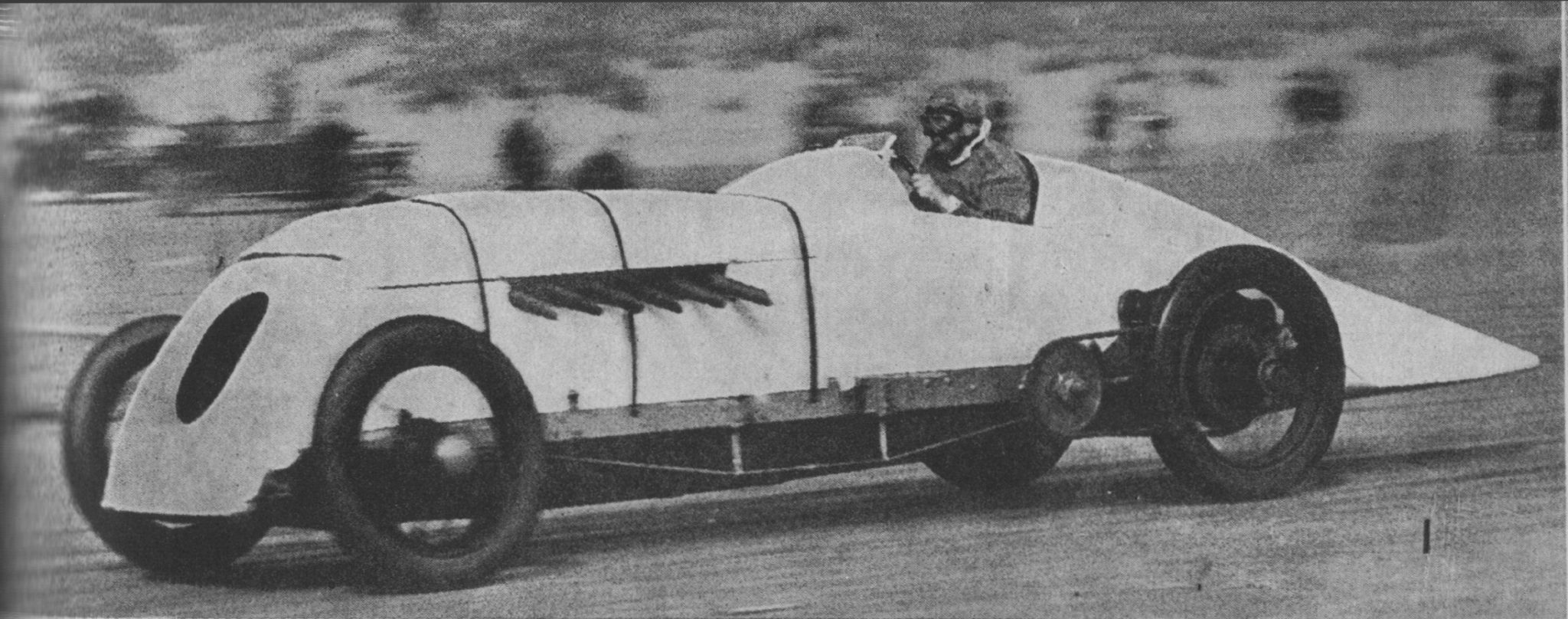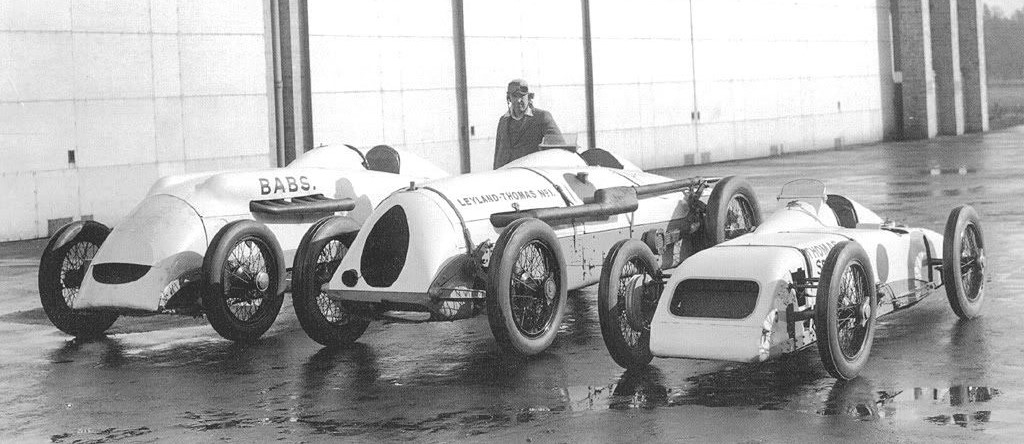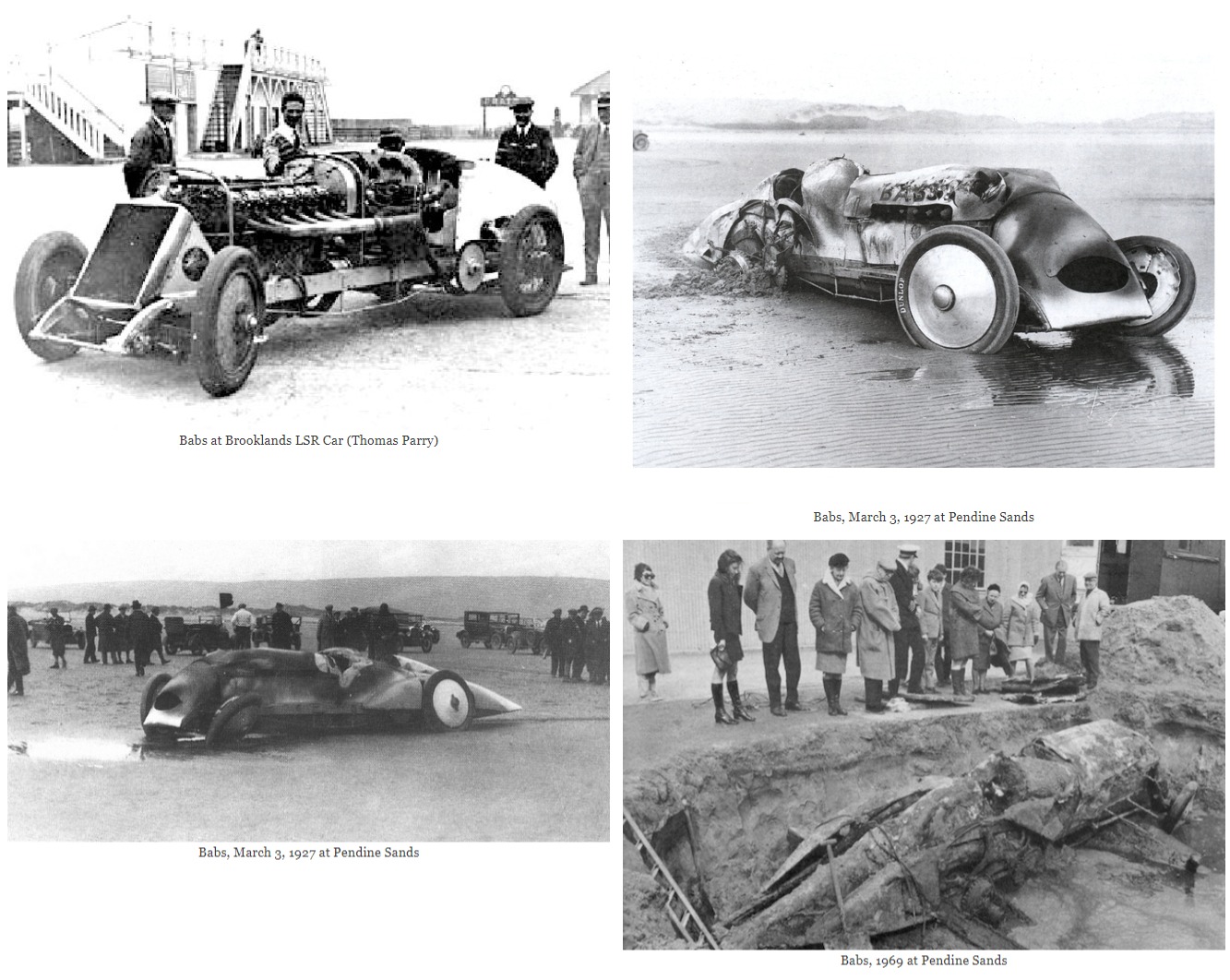
Chitty Bang Bang 4 was also built at Higham Park with a huge 27-litre aero engine, This car was called the “Higham Special” and later “Babs”. It was Louis Zborowski’s largest open-wheel, front-engined racing car. Using a 450 hp (340 kW) V12 Liberty aero engine of 27 litres capacity, with a gearbox and external chain-drive from a pre-war Blitzen Benz, it was the largest capacity racing car ever to run at Brooklands. Still not fully developed by the time of Zborowski’s death in November 1924, it was purchased from his estate by J.G. Parry-Thomas for the sum of £125 Pound sterling.
Parry-Thomas changed the car’s name to Babs. Babs was fitted with yet another body, partially enclosing the drive and rear wheels by fairings, a rebuilt four Zenith carburettors and his own design of pistons. In April 1926, Parry-Thomas used the car to win the Land speed record at 171.02 mph (273.6 km/h).
On March 3, 1927 with an improved Babs, Parry-Thomas returned to Pendine to regain his own world land speed record that had been broken just weeks earlier by Malcolm Campbell on the same beach. On February 4th. Campbell set the land speed record (in an average of two runs) at 174.883 mph (281.447 km/h)
Parry-Thomas has an exceptional first run, reported at 180mph (289.682 km/h), however a spectator walked through the timing beam unfortunately voiding this run. Parry-Thomas went for a second attempt and during his return run, he lost control and the car flipped killing him. As a mark of respect, following the inquest, Babs was buried in the dunes at Pendine Sands.
In 1967 Owen Wyn Owen, who was a automobile restorer, decided to excavate and restore Babs. The site of the burial was identified from old photographs, once found and granted permission for the excavation, Babs was exhumed in 1969.
At the time of the accident in 1927 it was thought that the right-hand chain had broken and had hit Thomas, causing a fatal head injury as the car was rolling. During the subsequent restoration of the car, it was found that this could not have been the case and that it was more likely that Thomas had been killed as a result of the injuries he sustained while the car rolled and slid along the beach.
The 15 year restoration work took place in Owen’s garage in Capel Curig UK. Babs is now displayed in the Pendine Museum of Speed during the summer months and Brooklands Museum during the winter.


Pendine Sands
Pendine Sands has long been the site of motor racing due to the smooth sand that Pendine Sands provided it was deemed the best place in Britain to attempt Land Speed record breaking in the late 1920s. Pendine Sands is best known where Malcolm Campbell and J. G. Parry-Thomas set the world land speed record five times between 1924 and 1927.
Pendine Sands is 7 miles (11 km) of beach on the shores of Carmarthen Bay on the south coast of Wales. It stretches west to east from Gilman Point to Laugharne Sands. A recent ban on vehicles driving on the hallowed sands has been reversed. The areas you can drive on are limited now.
The Pendine Museum of Speed is dedicated to the use of Pendine Sands for land speed record attempts. It was opened in 1996 in the village of Pendine, on the south coast of Wales, and is owned and run by Carmarthenshire County Council. The museum received 33,522 visitors in 2009.
The Brooklands Museum is a motoring and aviation museum occupying part of the former Brooklands motor-racing track in Weybridge, Surrey, England.

Parry-Thomas
John Godfrey Parry-Thomas (6 April 1884 – 3 March 1927) was a Welsh engineer and motor-racing driver who at one time held the land speed record. He was the first driver to be killed in pursuit of the land speed record.
Parry-Thomas became chief engineer at Leyland Motors, a company whose main products were commercial vehicles. He filed for and received a number of patents, in the fields of electrical and automotive engineering. After the First World War he and his assistant Reid Railton designed the Leyland Eight luxury motor car, which was intended to compete with Rolls-Royce. His experience of driving this car around Brooklands in 1920 persuaded him to give up his career with Leyland to become a full-time motor-racing driver and engineer.
In partnership with another engineer, Ken Thomson, Parry-Thomas started Thomas Inventions Development Co., a motor-racing engineering and car-building firm, based within the Brooklands race track.
From 1923 he lived at Brooklands in a bungalow. It was an ascetic life, shared only with two Alsatian dogs and his cars. After his death, this company became Thomson & Taylor. They were active between the wars and built several of the famous land speed record breaking cars of the day such as Malcolm Campbell’s Blue Bird.
Parry-Thomas achieved some success on the circuit, winning 38 races in five seasons and setting numerous records. Parry-Thomas was buried in St Mary’s Churchyard in Byfleet, Surrey, close to the Brooklands Circuit.


You must be logged in to post a comment.